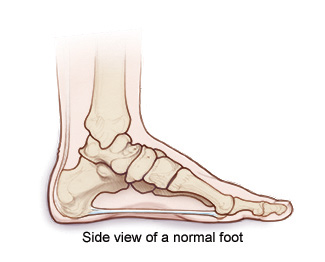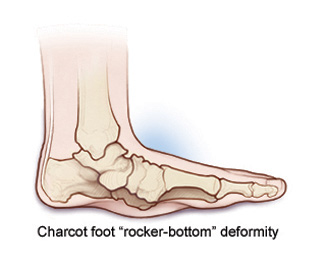Charcot foot
/fʊt/
1. [noun] charcot foot is a rare but serious complication that can affect persons with peripheral neuropathy, especially those with diabetes mellitus. Charcot affects the bones, joints, and soft tissues of the foot or ankle. The bones become weak and can break and the joints in the foot or ankle can dislocate. If not caught in its earliest stage, the joints in the foot collapse and the foot eventually becomes deformed. A deformed foot can cause pressure sores to develop in the foot or ankle. An open wound with foot deformity can lead to an infection and even amputation. Early diagnosis and treatment can prevent more damage and avoid deformity and other complications . Treatment has three goals: take the weight off the foot, treat bone disease (usually with cast; bisphosphonates and other supplements are sometimes used), and prevent new foot fractures. The first and most important treatment is rest or to take the weight off of the affected foot (also called “offloading”). In the early stage of Charcot foot, offloading helps prevent inflammation and stops the condition from getting worse and prevents deformity . Protected weight-bearing (walking in a walking boot) in later stages can prevent complications from the existing deformity and avoid new deformities. Offloading may involve putting the foot into a cast, which protects it and keeps it from moving. The patient usually wears a series of casts or a removable cast walker over a total of 8 to 12 weeks. Crutches, knee walker, or a wheelchair are used to avoid putting any weight on the affected foot. The cast is changed several times as the swelling in the foot goes down. A cast stays on the foot until the redness, swelling, and heat are resolved. After the cast is removed, the patient is given a prescription for footwear. Prescription orthopaedic footwear properly fits the foot and relieves pressure points to prevent a repeat injury and ulcers. A common device used is a Charcot Restraint Orthotic Walker (CROW). The doctor may also recommend changes in the patient’s activity to avoid further trauma to the feet. Surgery is recommended for those patients who have severe ankle and foot deformities that are unstable and at high risk of developing a foot ulcer. In addition, if the deformity makes braces and orthotics difficult to use, surgery may be indicated. After surgery, the patient will have to avoid putting full weight on the Charcot foot for an extended period of time. All people with Charcot foot must be dedicated to wearing protective footwear and taking extra care of their feet for the rest of their lives. Education of the patient and family members about preventive foot care and signs to watch for is an important part of preventing future problems See: https://my.clevelandclinic.org/health/diseases/15836-charcot-foot ; Accessed May 3 2019
Source: https://my.clevelandclinic.org/health/diseases/15836-charcot-foot


Frequently Asked Questions
How does the term 'Charcot' help us remember the role of nerve issues in this foot condition?
The term 'Charcot' honors the French neurologist Jean-Martin Charcot and hints at its connection with nerve damage. This reminder is useful in understanding that diminished nerve sensation can allow structural foot changes to progress unnoticed.
How can everyday walking or standing affect a foot with reduced nerve sensation?
Simple, daily movements can stress a foot where nerve feedback is compromised. Without the usual signals of pain, subtle injuries to bones and joints might accumulate, leading to gradual structural changes in the foot.
In what ways does Charcot foot differ from a typical sprain or broken bone in the foot?
Unlike a straightforward sprain or fracture that usually produces immediate discomfort, Charcot foot develops quietly over time. It involves a progressive weakening and disintegration of bone and joint structure, often without the usual warning signs.